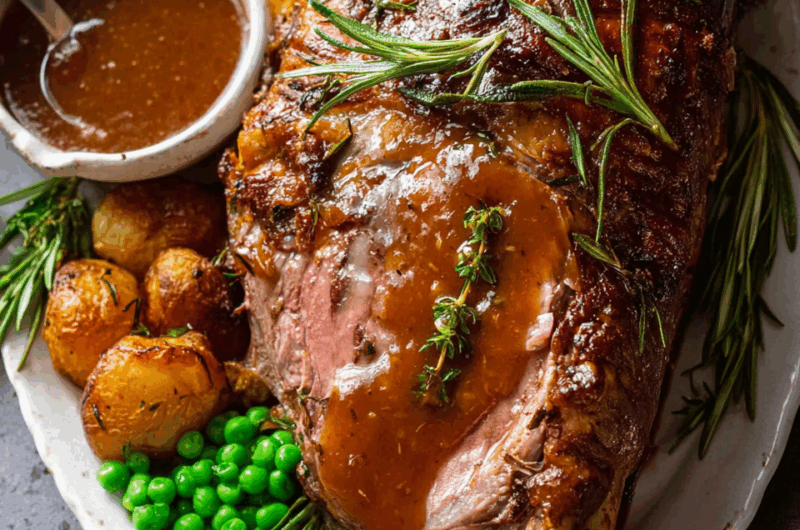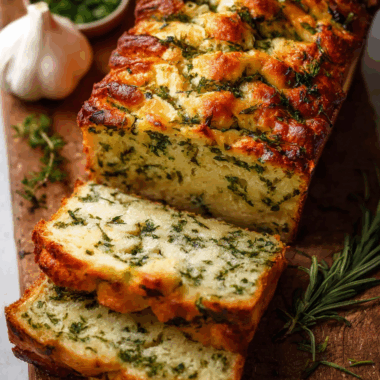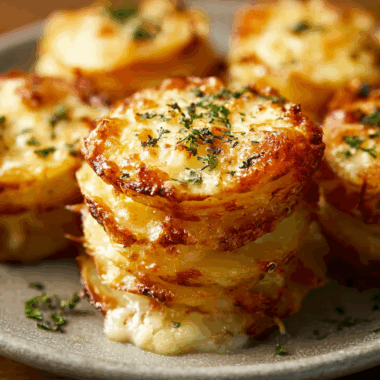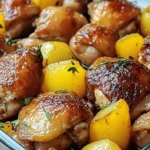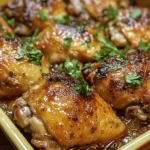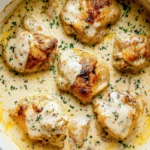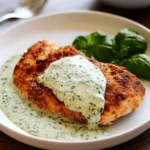Roast Lamb Leg with Gravy is a true celebration of slow-cooked flavor and rustic elegance. Infused with garlic, rosemary, and thyme, the lamb cooks low and slow until it’s so tender it practically falls off the bone. A rich, savory gravy made from pan drippings takes it to the next level—earthy, robust, and perfect for drizzling over every slice. Whether you’re preparing a holiday feast, a Sunday family dinner, or simply indulging in a comforting homemade roast, this dish never disappoints. It’s hearty, flavorful, and soul-warming—everything a traditional roast should be. Pair it with creamy mashed potatoes, roasted carrots, or green beans for a timeless, satisfying meal that brings everyone to the table.
Full recipe:
Ingredients:
-
1 whole bone-in lamb leg (approx. 2.2–2.5kg / 5–5.5 lb)
-
1 tablespoon olive oil
-
1 tablespoon fresh rosemary, finely chopped
-
1 tablespoon fresh thyme leaves
-
6 garlic cloves, minced
-
1 tablespoon salt
-
1 teaspoon black pepper
-
2 onions, sliced into thick rounds
-
1 cup (250ml) water
-
2 cups (500ml) beef or lamb stock
For Gravy:
-
Pan drippings from roast
-
2 tablespoons flour
-
1 1/2 cups (375ml) stock (or water + bouillon)
-
Salt and pepper to taste
Directions:
-
Preheat oven to 160°C / 320°F (standard) or 140°C / 285°F (fan).
-
Combine olive oil, rosemary, thyme, garlic, salt, and pepper into a paste. Rub thoroughly all over the lamb leg.
-
Place onion slices in a roasting pan and rest lamb on top. Add 1 cup water to pan base.
-
Cover tightly with foil and roast for 4.5 hours. Remove foil and roast uncovered for 30–45 minutes until browned.
-
Transfer lamb to a board, loosely cover with foil, and rest for 20 minutes.
-
For gravy: Skim excess fat from pan, place over medium heat. Add flour and cook 1 min. Slowly whisk in stock, scraping up browned bits. Simmer until thickened.
-
Serve lamb shredded with gravy poured over top.
Prep Time: 15 minutes | Cooking Time: 5 hours | Total Time: 5 hours 15 minutes
Kcal: 525 kcal | Servings: 6–8 servings
Roast Lamb Leg with Gravy – A Timeless Centerpiece of the Table
When it comes to hearty, celebratory meals, few dishes rival the glory and flavor of a perfectly roasted leg of lamb. This Roast Lamb Leg with Gravy brings together tradition, comfort, and simplicity in one stunning centerpiece. Slowly roasted until fall-apart tender, and paired with a rich, homemade pan gravy, this dish transforms any meal into a memorable feast. Whether you’re hosting a Sunday family dinner or planning a holiday gathering, roast lamb is a showstopper that’s surprisingly easy to master.
Rich in flavor, robust in texture, and deeply satisfying, this roast is steeped in culinary tradition. With fresh garlic, rosemary, thyme, and a slow, gentle roasting process, it showcases the best of classic techniques while delivering mouthwatering results. Plus, the pan gravy made from the drippings takes the entire dish to a whole new level of indulgence.
The History and Significance of Roasting Lamb
Roasting lamb has deep roots in global culinary traditions. In Mediterranean and Middle Eastern cultures, lamb is considered a prized meat—celebrated during religious and seasonal feasts. From Greek Easter lamb on a spit to Moroccan mechoui and British Sunday roasts, this ingredient has long been associated with special occasions, gatherings, and family.
Lamb leg, in particular, is favored for its balance of lean meat and flavor-rich fat. When slow-roasted, the connective tissues break down beautifully, resulting in tender meat that’s juicy and flavorful without being greasy. Paired with a pan gravy made from its own juices, it becomes a symphony of savory, herbaceous goodness that pays homage to centuries of culinary craft.
Why This Roast Lamb Recipe Stands Out
There are many variations of roast lamb, but this recipe excels for several reasons—making it not only traditional but also fail-proof and deeply flavorful.
1. It’s Foolproof for Any Skill Level
This roast lamb leg is incredibly forgiving. It doesn’t require fancy tools or complicated techniques. With just a handful of fresh ingredients and a few hours in the oven, you’ll achieve restaurant-quality results.
2. Minimal Prep, Maximum Flavor
Thanks to a simple garlic and herb rub, the lamb is deeply seasoned with just a few pantry staples—olive oil, garlic, rosemary, thyme, salt, and pepper. No marinades or overnight prep needed.
3. Perfect Texture Every Time
Slow-roasting at a low temperature ensures the lamb becomes ultra-tender, while a final uncovered roast adds the perfect golden-brown crust.
4. Homemade Gravy Made Simple
No store-bought mixes here. The pan gravy is made directly from the lamb’s drippings—infused with herbs and onions—then thickened into a luscious, silky sauce you’ll want to pour over everything.
5. It’s a Crowd-Pleaser
This dish is a guaranteed hit with meat lovers and foodies alike. Serve it shredded or sliced, rustic or elegant, and it fits any occasion.
Nutritional Benefits of Lamb
Lamb isn’t just flavorful—it’s packed with important nutrients. Here’s what a portion of roast lamb brings to the table:
High-Quality Protein
Lamb is a rich source of complete protein, which is essential for muscle repair, immune function, and satiety.
Iron and Zinc
Compared to other meats, lamb is especially high in iron and zinc—critical for energy levels, immune support, and cell regeneration.
B Vitamins
Lamb is abundant in vitamin B12 and niacin, which aid in red blood cell production and brain function.
Healthy Fats
Although lamb contains saturated fat, it also has healthy monounsaturated fats—particularly when raised on pasture. In moderation, these fats contribute to heart health and hormone balance.
Tips for a Perfect Roast Every Time
Even the simplest recipes benefit from a few expert techniques. Follow these tips to get the best flavor and texture out of your roast lamb leg.
Bring Lamb to Room Temperature
Allow the meat to sit out for 30–60 minutes before roasting. This promotes even cooking and a better crust.
Use a Roasting Rack (or Onions!)
Elevating the lamb helps air circulate evenly. In this recipe, sliced onions double as a flavorful rack, infusing the drippings with sweet, savory notes for the gravy.
Cover for Moisture, Uncover for Crust
The lamb is first roasted covered to lock in moisture and tenderize the meat. Then, it’s roasted uncovered to develop that beautifully browned exterior.
Don’t Skip the Resting Period
Resting allows juices to redistribute throughout the meat. Skipping this step can lead to dry, tough slices.
Make the Gravy While the Lamb Rests
Use that time wisely—skim the fat from the pan, whisk in flour, and slowly incorporate stock to build a gravy that’s velvety and rich.
Serving Suggestions and Pairings
Roast lamb is incredibly versatile when it comes to sides and pairings. Here are some classic and creative ideas to complete your meal:
Classic Side Dishes
-
Roasted potatoes or creamy mashed potatoes
-
Steamed green beans with butter and lemon
-
Honey-glazed carrots or roasted parsnips
-
Yorkshire pudding or crusty bread for sopping up gravy
Fresh Additions
-
A bright arugula or fennel salad to cut the richness
-
Mint sauce or chimichurri for a tangy contrast
-
Lemon wedges for a squeeze of brightness
Beverage Pairings
-
Bold red wines like Shiraz, Cabernet Sauvignon, or Malbec
-
Dry rosé for a lighter touch
-
Sparkling water with herbs or citrus for non-alcoholic refreshment
Holiday and Special Occasion Favorite
This roast lamb recipe isn’t just for Sunday dinners—it’s perfect for celebrating. From Easter and Christmas to birthday dinners or cozy fall gatherings, it adds elegance and heartiness to any spread.
Because it feeds a crowd and requires only a few steps, it’s ideal for hosts who want something impressive without being chained to the kitchen all day. Plus, leftovers are fantastic—use them in wraps, grain bowls, or shredded into stews.
How to Store and Reheat Leftovers
Proper storage ensures that your leftover lamb remains tender and flavorful.
Refrigerate:
Store cooled lamb in an airtight container for up to 4 days. Store gravy separately.
Freeze:
Shred or slice and freeze lamb in portions. Use freezer-safe bags or containers. Keeps well for up to 2 months.
Reheating Tips:
Reheat lamb gently in a covered dish in the oven or microwave with a splash of broth or gravy to retain moisture. Reheat gravy in a saucepan over low heat, stirring constantly.
Creative Ways to Use Leftover Roast Lamb
Don’t let leftovers go to waste—this roast is just as delicious the next day. Try these ideas:
-
Lamb Sandwiches with arugula, aioli, and pickled onions
-
Lamb Tacos with tzatziki, cucumbers, and feta
-
Lamb Shepherd’s Pie with mashed potato topping
-
Lamb and Barley Soup with root vegetables
-
Pasta with Lamb Ragu using shredded meat and tomato sauce
Each idea transforms your roast into something new while maintaining its deep, savory base flavor.
Conclusion
Roast Lamb Leg with Gravy is more than just a meal—it’s an experience rooted in tradition, hospitality, and heartwarming flavor. From the first aromatic waft of garlic and rosemary to the final drizzle of rich, silky gravy, this dish brings people together around the table like few others can. It’s simple enough for everyday cooks, elegant enough for holidays, and satisfying enough to earn a permanent place in your recipe collection. With a few basic ingredients and a little patience, you can create a meal that feels both timeless and extraordinary.

